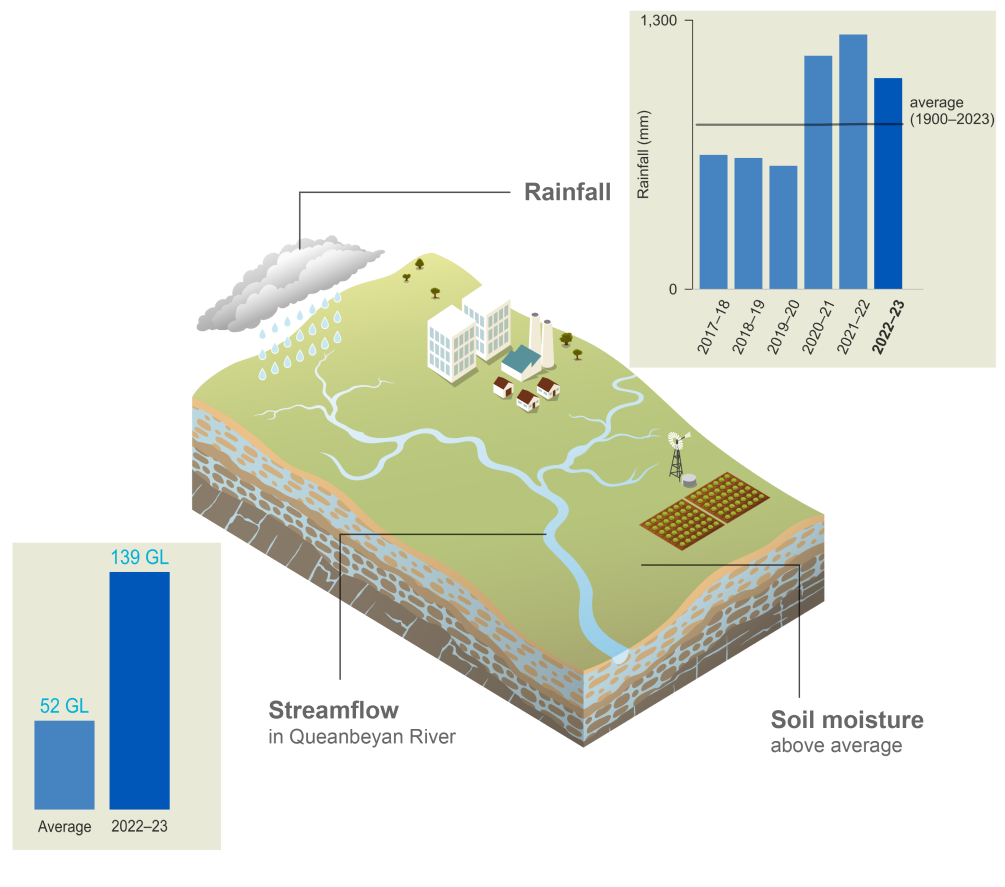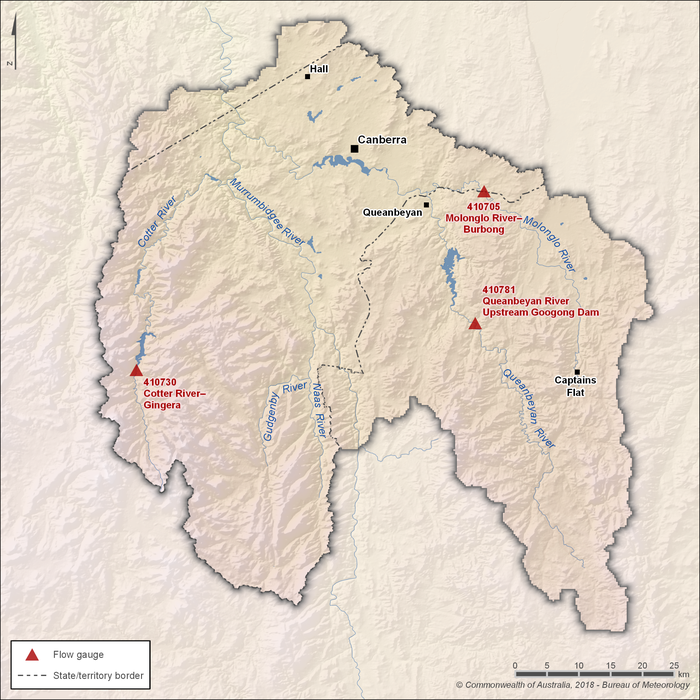Canberra: Climate and water
For the water account period 01 July 2022 - 30 June 2023
- Total annual rainfall during the 2022-23 year was above average for the third consecutive year, with the region experiencing its wettest three-year period on record.
- It was the wettest August to November period and wettest spring on record, resulting in areas of flooding.
- Soil moisture in the root zone (0-1 m depth) was average to above average across the region, except for the southern tip of the Queanbeyan River catchment area, which had below-average soil moisture.
- Total annual flows in the region's major rivers was above average at all streamflow sites, with total annual flows in the Molonglo River at Burbong and the Queanbeyan River upstream of Googong Dam more than double the average annual flow volume.

For further information on the region's climate and water conditions during the 2022-23 year scroll down this page or click on the links below:
About the region
- The Canberra region has a subtropical highland climate, characterised by cool to cold winters, and mild to warm summers.
- Rainfall is relatively uniform throughout the year, with long-term monthly averages ranging from 50-75 mm. Higher rainfall totals are more common during mid-spring and summer (October to February), where thunderstorm activity is more prominent.
- Streamflows in the region's rivers are typically higher during winter and spring (June to November) due to increased runoff from partially saturated catchments in autumn and winter (March to August). In addition, streamflows in the Murrumbidgee River can also be influenced by water diversions from the Snowy Mountain Scheme.
Climate conditions
Rainfall
Figure C1 Annual and monthly rainfall deciles for the Canberra region during the 2022–23 year
- Total area-averaged rainfall for the 2022-23 year was 1,020 mm, 28% above the mean value of 797 mm. This was the third consecutive year of above average rainfall resulting in the region's wettest three year period on record.
- July 2022 was very dry in the south and the region as a whole had less than half the July average rainfall.
- A negative Indian Ocean Dipole developed during August 2022 and a third consecutive La Niña event was declared in September 2022. A negative Indian Ocean Dipole generally increases the chances of above average winter to spring rainfall in this part of the country and La Niña events tend to increase the chances of above average rainfall during spring and summer.
- In 2022-23, the region experienced its wettest August to November period on record, which included the wettest spring on record.
- During spring, a series of low pressure systems and surface troughs drew tropical air from the warm ocean waters, delivering thunderstorms and heavy rain to the region which resulted in flooding. October 2022 had more than twice the monthly average rainfall and was the third wettest October on record. More information on this event can be found in the Bureau's Special Climate Statement 77.
- With the exception of December and February, average to above average rainfall continued through to mid-autumn.
- Rainfall during May 2023 and June 2023 was below average, particularly over the south east part of the region.
- More information on Australia's climate and water over the 2022-23 year can be found at: Financial year climate and water statement 2022-23.
Figure C2 Total monthly rainfall for the Canberra region during the 2022–23 year compared with the average and percentiles for the region
- Rainfall from August to November 2022 was the region's wettest August-November period on record, with rainfall during August 2022 and October 2022 peaking above the 90th percentile.
- No month ranked below the 10th percentile, however, July 2022 was particularly dry.
- Rainfall during the December 2022 to June 2023 period was closer to average.
Actual evapotranspiration
Figure C3 Annual and monthly actual evapotranspiration for the Canberra region during the 2022–23 year
- Total area-averaged actual evapotranspiration for the 2022-23 year was very much above average across the region, with high rainfall maintaining water availability across the region. Parts of the Queanbeyan River and Molonglo River catchment areas experienced their highest evapotranspiration on record.
- Despite below average rainfall occurring during July 2022, evapotranspiration was above average for most of the region following above average rainfall during the previous few months.
- A record wet August to November period further boosted water availablity across the region, resulting in higher than average evapotranspiration throughout the rest of 2022.
- Evapotranspiration remained average to above average throughout summer and into autumn.
- From March 2023 onwards, evapotranspiration remained predominantly above average across the region, with above average rainfall during March 2023 and April 2023 helping to maintain high water availability leading into the cooler months of the year.
Soil moisture
Figure C4 Annual and monthly soil moisture deciles for the Canberra region during the 2022–23 year
- Soil moisture in the root zone (0–1 m depth) for the 2022-23 year was average to above average across the region, except for the southern tip of the Queanbeyan River catchment area, which had below average soil moisture.
- At the beginning of the 2022-23 year, the soil moisture was average for most of the region, despite below average rainfall, except for the southern parts of Namadgi National Park, where the soil moisture was below average.
- A very wet August to November period contributed to very much above average soil moisture for most of the region, with some areas experiencing their highest soil moisture on record during October 2022 and November 2022.
- Soil moisture remained average to above average throughout the region during December, but with closer to average rainfall and warmer temperatures, the soil moisture returned to average across the entire region during the last two months of summer.
- Despite rainfall in March 2023 and April 2023 being above average, this drying trend continued with the soil moisture being average to below average during the first two months of autumn. The soil moisture returned to average to above average conditions in May 2023.
- By June 2023, soil moisture was average to below average following below average rainfall during the last two months of the 2022-23 year.
- More information on soil moisture distribution across the Canberra region is available in the Australian Water Outlook.
Streamflow responses

Figure C5 Key flow gauging stations along the main
rivers within the Canberra region
- The Cotter and Queanbeyan rivers contribute most of the inflows to the storages in the Canberra region.
- Molonglo River, one of the major tributaries of the Murrumbidgee River, flows through the Canberra city centre where it is dammed to form Lake Burley Griffin.
Figure C6 Total monthly flow for major rivers in the Canberra region during the 2022–23 year compared with the average and percentiles
- Total annual flows in the region's major rivers were above average during the 2022-23 year, with total annual flows in the Molonglo River at Burbong (Station 410705) and the Queanbeyan River upstream of Googong Dam (Station 410781) more than double the average annual flow volume.
- Following record spring rainfalls, all streamflow sites peaked above the 90th percentile in August, October and November. The Cotter River at Gingera recorded its highest October and November streamflows on record, while the Queanbeyan River upstream of Googong Dam experienced its highest October and second-highest November streamflows on record, reflecting the heavy rainfall during this period which caused flash flooding around Canberra. More information on this extreme rainfall event can be found in the Bureau's Special Climate Statement 77.
- During the last six months of the year, rainfall was closer to average resulting in most streamflows trending near or below average through to the end of the 2022-23 year.
Note: Streamflow data for the Cotter River at Gingera (Station 410730) was unavailable during March 2023 and April 2023









